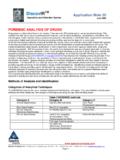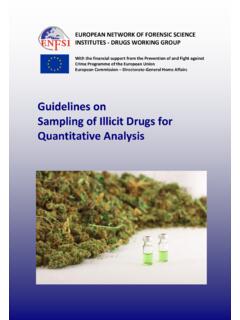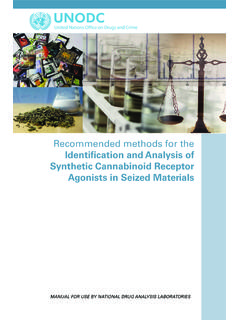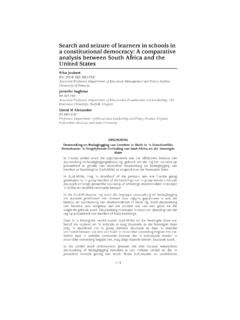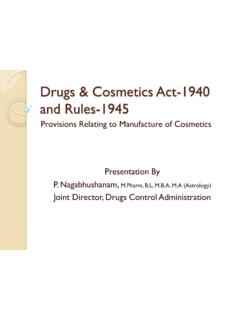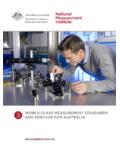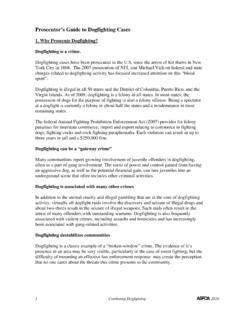Transcription of Recommended methods for the Identification and …
1 Recommended methods for the Identification and analysis ofCocaine in seized MaterialsManual for use by national drug analysis laboratoriesPhoto credits:UNODC Photo Library; UNODC/Ioulia Kondratovitch; Alessandro and Scientific SectionUnited nations office on drUgS and crimeViennaRecommended methods for the Identification and analysis of Cocaine in seized Materials(Revised and updated)MANUAL FOR USE BY NATIONAL drug analysis LABORATORIESUNITED NATIONSNew York, 2012iiNoteOperating and experimental conditions are reproduced from the original reference materials, including unpublished methods , validated and used in selected national laboratories as per the list of references. A number of alternative conditions and substitution of named commercial products may provide comparable results in many cases, but any modification has to be validated before it is integrated into laboratory of names of firms and commercial products does not imply the endorse-ment of the united language: English united nations , March 2012.
2 All rights designations employed and the presentation of material in this publication do not imply the expression of any opinion whatsoever on the part of the Secretariat of the united nations concerning the legal status of any country, territory, city or area, or of its authorities, or concerning the delimitation of its frontiers or boundaries. This publication has not been formally production: English, Publishing and Library Section, united nations office at Introduction .. Background .. Purpose and use of the manual .. 12. Physical appearance and chemical characteristics of coca leaf and illicit materials containing cocaine .. 33.
3 Description of the pure compounds .. 54. Illicit production of cocaine .. Production from coca leaves .. Chemical synthesis of cocaine .. 155. Qualitative and quantitative analysis of materials containing cocaine .. Sampling .. analysis of coca leaf .. Physical Identification .. Chemical analysis of coca leaf (whole or powdered) .. analysis of coca paste and cocaine .. Presumptive tests for cocaine .. Colour test .. Odour test .. Microcrystal tests .. Solubility tests .. Anion tests .. Thin Layer Chromatography (TLC) .. Gas Chromatography-Mass Spectrometry (GC-MS) .. Gas Chromatography (GC) with flame ionization detection (GC-FID).
4 High Performance Liquid Chromatography (HPLC) .. Fourier Transform Infrared (FTIR) Spectroscopy .. Ultraviolet (UV) Spectrophotometry .. The analysis of cocaine enantiomers .. 366. References .. 39ivAcknowledgementsUNODC s Laboratory and Scientific Section (LSS, headed by Dr. Justice Tettey) wishes to express its appreciation and thanks to Dr. Michael Collins, Dr. Helen Salouros and Mr. Hilton Swan for the preparation of the first draft of the present revised and updated would also like to thank Prof. Niamh Nic Daeid, Dr. Kathleen Savage, Dr. Udo Zerell and Dr. Pierre Esseiva for their expert reviews and valuable preparation of the present manual was coordinated by Ms.
5 Yen Ling Wong, staff of LSS. The contribution of other UNODC staff is gratefully BackgroundCocaine is a highly addictive stimulant that occurs naturally as an alkaloid of the coca plant (Erythroxylon coca or Erythroxylon novogranatense). Traditionally, the coca leaves are chewed or brewed as tea. In the early 1900s, purified cocaine was used in most tonics and elixirs to treat a wide variety of to its high potential for abuse and dependence, coca leaf and cocaine were put under international control in the Schedule I of the Single Convention on Narcotics Drugs, 1961. However, in some countries, cocaine still has legitimate medical uses, such as local anaesthesia for eye, ear and throat two main chemical forms of cocaine are the water-soluble salt form and the water-insoluble cocaine base form.
6 Generally, the salt form can be injected or snorted while the base form ( crack ) is usually excessive or prolonged abuse, cocaine can cause development of tolerance, strong psychological dependence, malnutrition, disorientation, hallucination and paranoid Purpose and use of the manualThe present manual is one in a series of similar publications dealing with the Identification and analysis of various types of drugs under international control. These manuals are the outcome of a programme pursued by UNODC since the early 1980s, aimed at the harmonization and establishment of Recommended methods of analysis for national drug analysis present manual is a revision of the manual on Recommended methods for testing cocaine (ST/NAR/7), which was published in 1986.
7 It has been prepared taking into account developments in analytical technology with a view to providing the basis for reliable forensic evidence on cocaine-containing seized line with the overall objective of the series, the present manual suggests approaches that may assist drug analysts in the selection of methods appropriate to the sample 2 Recommended methods for the Identification and analysis of Cocaine in seized Materialsunder examination and provide data suitable for the purpose at hand, leaving room also for adaptation to the level of sophistication of different laboratories and the various legal needs. The majority of methods included in the present manual are validated methods , which have been used for a number of years in reputable labo-ratories and as part of inter-laboratory studies, collaborative exercises and proficiency tests.
8 The reader should be aware, however, that there are a number of other methods , including those published in the forensic science literature, which may also produce acceptable results. Any new method that is about to be used in the reader s labora-tory must be validated and/or verified prior to routine addition, there are a number of more sophisticated approaches, but they may not be necessary for routine operational applications. Therefore, the methods described here should be understood as guidance, that is, minor modifications to suit local circumstances should not normally change the validity of the results. The choice of the methodology and approach to analysis as well as the decision whether or not additional methods are required remain with the analyst and may also be dependent on the availability of appropriate instrumentation and the level of legally acceptable proof in the jurisdiction within which the analyst is also drawn to the vital importance of the availability to drug analysts of reference materials and books on drugs of abuse and analytical techniques.
9 Moreo-ver, the analyst must of necessity keep abreast of current trends in drug analysis , consistently following current analytical and forensic science s Laboratory and Scientific Section would welcome observations on the contents and usefulness of the present manual. Comments and suggestions may be addressed to:Laboratory and Scientific SectionUnited nations office on Drugs and CrimeVienna International Box 5001400 ViennaAustriaFax: (+43-1) 26060-5967E-mail: manuals, as well as guidelines and other scientific-technical publications may be requested by contacting the address Physical appearance and chemical characteristics of coca leaf and illicit materials containing cocaineCoca leafCoca leaves are somewhat similar in appearance to Laurus nobilis leaves.
10 Different Erythroxylon species produce leaves varying in size and appearance. In all species the upper side of the leaf is darker than the underside which may be grey-green in colour. On the underside of the leaves are found two lines parallel to the midrib which are considered to be characteristic of coca leaves of Erythroxylon coca Lam. are characteristically large and thick, broadly elliptic in shape, more or less pointed at the apex and dark green in colour. The leaves of Erythroxylon novogranatense (Morris) Hieron are smaller, narrower, thin-ner and rounded at the apex. They are bright yellow-green coloured. The leaves of Erythroxylon novograntense var. truxillense (Rusby) Plowman are even smaller and narrower.










